Ohio has a diverse geography, and its climate and soil vary greatly from region to region. Yet, despite this diversity, many flowers grow beautifully as annuals across The Buckeye State. So check out our list of 17 best annual flowers that grow well in most Ohio regions and many other growing zones across the US.
The two USDA Hardiness Zones in Ohio are zones 5 and 6, though zone 6 takes up a higher percentage of the state. However, annual flowers grow in many different zones for one season. Thus, even if the seed packet calls a flower a perennial, it might grow beautifully during the warmest months in your area.
Now on to our list of 17 annual flowers for Ohio gardeners! Which ones are your favorites?
1. Aster
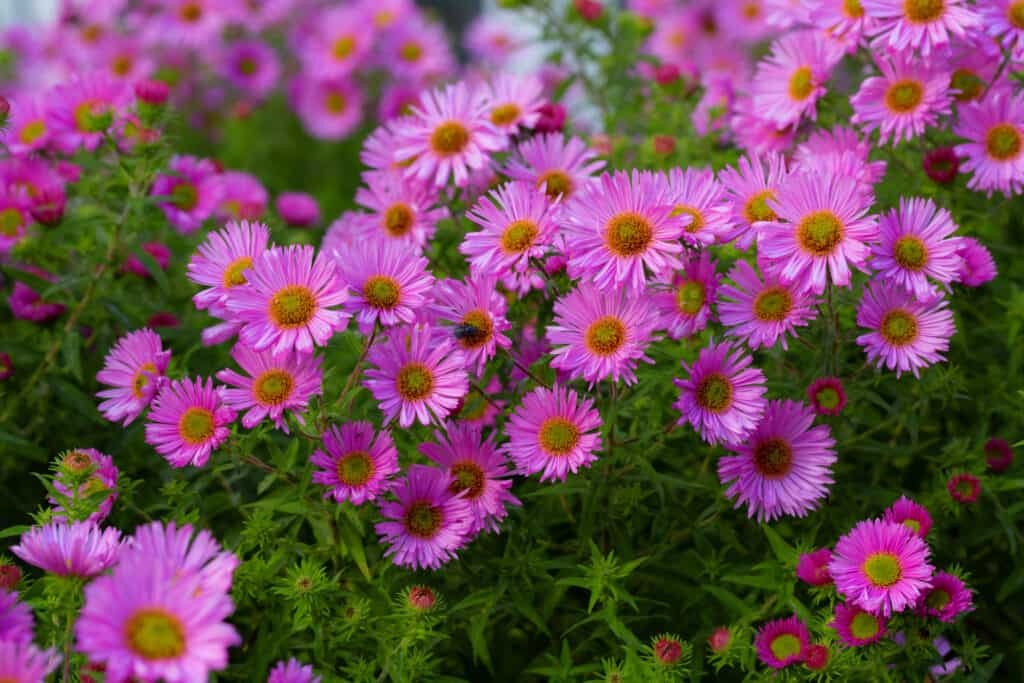
Asters have long stems and typically grow to be about two feet tall.
©iStock.com/Inna Giliarova
Planting aster plants in your Ohio garden containers and beds will provide lots of color from mid-summer through fall. Aster flowers come in many colors, including white, pink, purple, and blue. Asters grow best in full sun to partial shade and in well-drained soil.
Asters have long stems and typically grow to be about two feet tall. The flowers are small and have many petals arranged in a star shape, which is where they get their name. Aster flowers resemble daisies and are often used in bouquets or as decoration in vases.
Aster flowers are native to Europe, Asia, and North America and have been cultivated for centuries. In the wild, they typically grow in meadows or fields but can also be found in woods or on mountain slopes. In addition, asters attract bees, butterflies, and other pollinators to your garden beds and containers.
2. Baby’s Breath

Baby’s breath flowers are small, delicate blooms often used as filler in bouquets and floral arrangements.
©iStock.com/liuyushan
This classic filler flower is perfect for adding a bit of texture and interest to your garden. It’s pretty easy to grow and comes in white, pink, blue, and more colors.
Baby’s breath flowers are small, delicate blooms often used as filler in bouquets and floral arrangements. The tiny flowers are pale pink or white and have a light, sweet fragrance. Baby’s breath is popular for wedding bouquets and other special occasions because of its delicate beauty.
A baby’s breath plant can tolerate a wide range of growing conditions as a hardy plant. This annual flower grows best in sunny areas but can also grow in partial shade. The plant prefers well-drained soil and does not need much fertilizer.
Baby’s breath originates from Europe and Asia but also grows worldwide.
3. Begonias
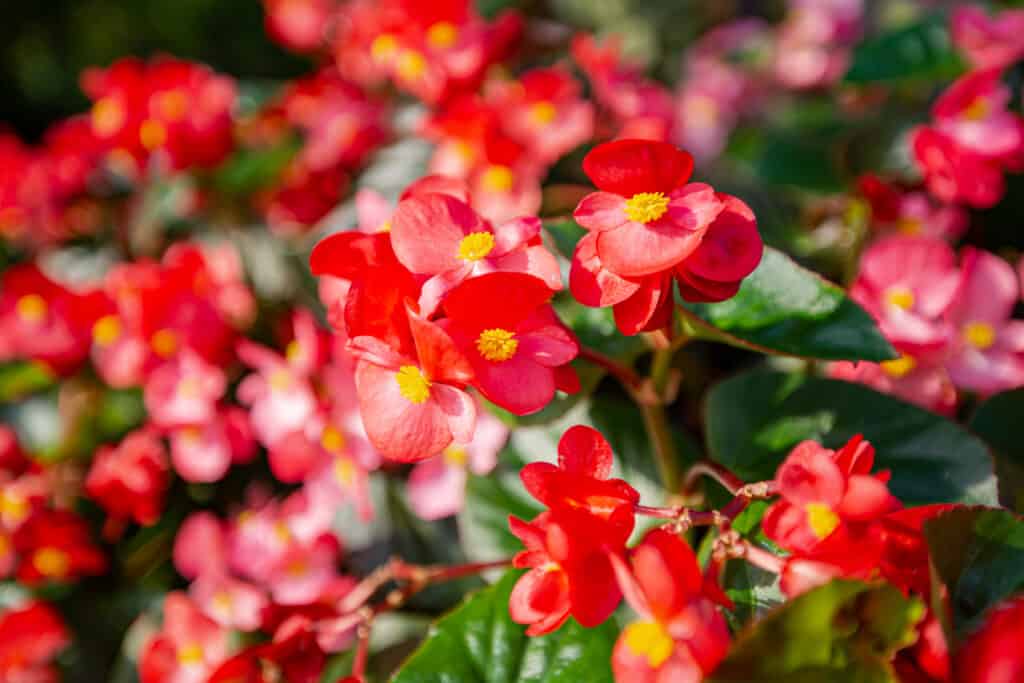
Begonia plants typically have large, dark green leaves and brightly colored flowers.
©iStock.com/deaw59
Like impatiens, begonias prefer shady areas and make a great addition to gardens and containers that need some color in low-light areas. In addition, begonia flowers come in a wide range of colors and textures, making them a versatile option for adding interest to your garden.
Begonia plants typically have large, dark green leaves and brightly colored flowers. Some standard colors of begonia flowers include pink, red, orange, and white. Begonia flowers are native to tropical and subtropical regions worldwide and thrive in warm climates. However, begonia flowers grow well as annuals in Ohio.
Did you know that begonias are part of the squash and pumpkin family of plants? Yes, they are! Like squash plants, wax and tuberous begonia flowers are edible. They taste similar to citrus but sometimes have a bitter aftertaste.
4. Bidens
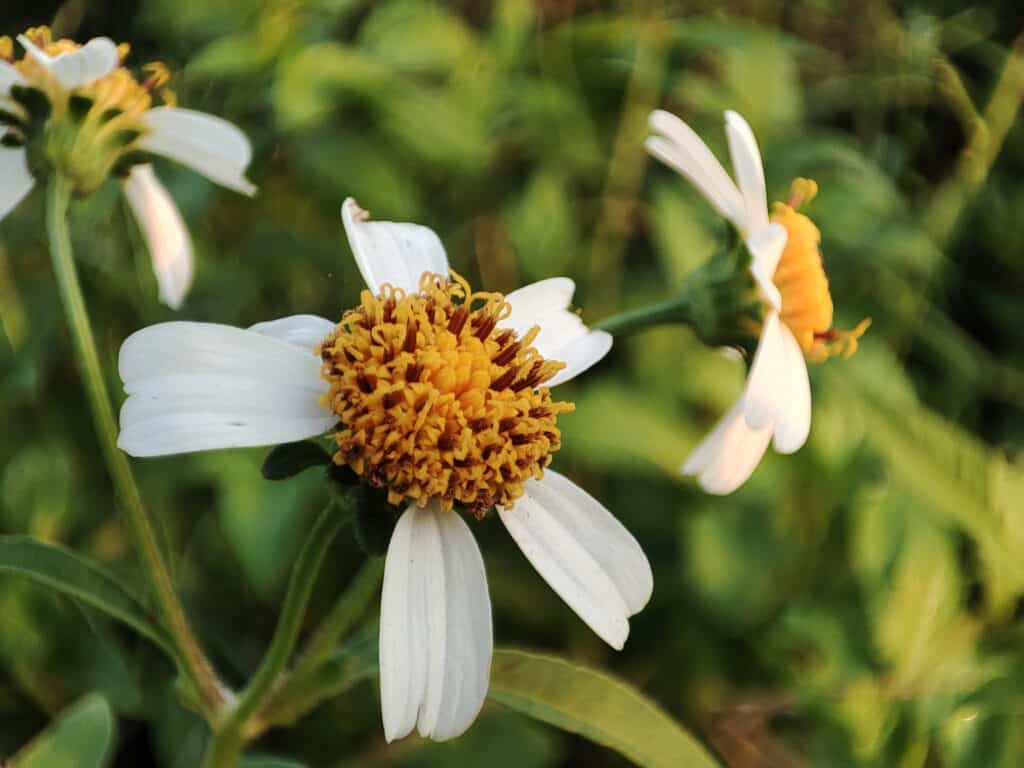
Also known as Beggarticks, Bidens flowers are small, yellow flowers that often grow in clusters.
©iStock.com/Luqman Hakim
The Bidens annual flower is perfect for adding yellow or white blooms to shady areas of your garden. These flowers come in mainly yellow, white, and orange.
Also known as Beggarticks, Bidens flowers are small, yellow flowers that often grow in clusters. The 5-petal flowers have a small central disc and long, thin petals that curve outward. These petite flowers on wiry stalks can range from about 1/2 inch to 1 inch in diameter. Bidens are native to North America and commonly grow in woodlands, fields, and roadsides.
Another benefit of Bidens for Ohio gardens is their nectar! These flowers are nectar-rich and a favorite of pollinators like bees and butterflies.
5. Celosia
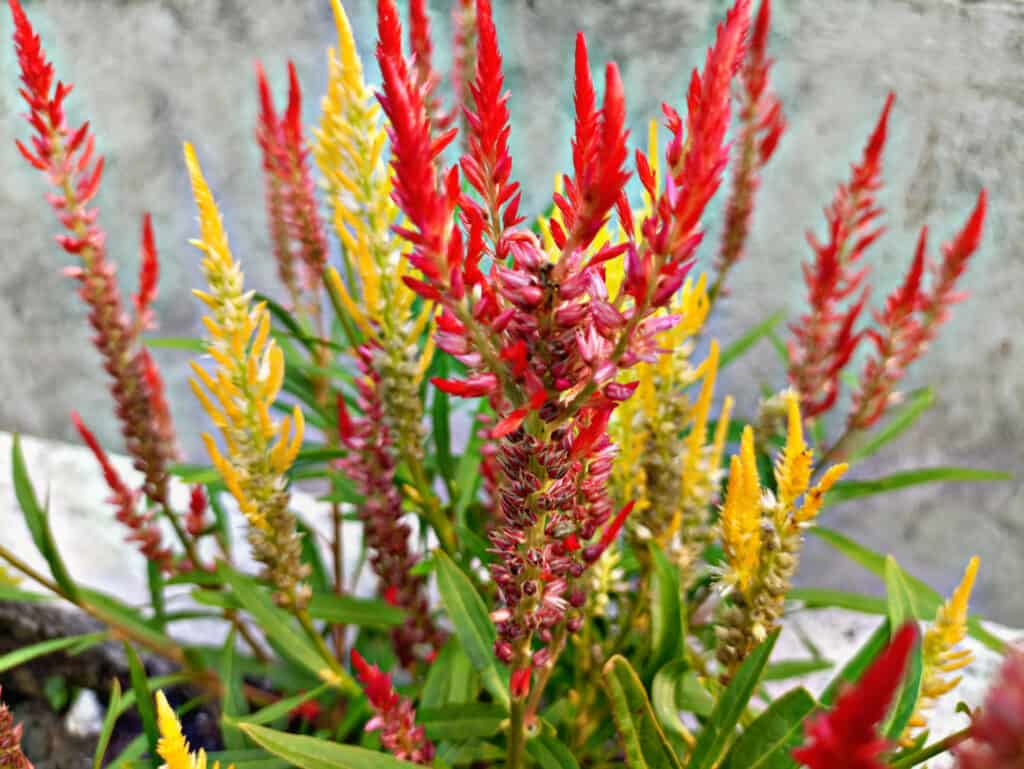
Cockscomb (Celosia cristata) is a type of celosia characterized by its crested blooms resembling the comb on a rooster’s head.
©iStock.com/Khodar Adi Handoko
If you’re looking for a unique annual flower to add to your Ohio garden plots, look no further than celosia. So many of these fluffy flowers look like brightly-colored feather dusters! Celosias come in various colors and textures, including feathery plumes and crested blooms.
Celosia prefers full sun and well-drained soil. These heat-loving annuals are native to tropical Africa and Asia but have been cultivated in gardens worldwide. The flowers of celosia look lovely in bouquets or dried arrangements.
Celosias come in various colors, including yellow, orange, pink, red, and purple. The flowers grow on tall stalks and can range in size from a few inches to over a foot long.
Cockscomb (Celosia cristata) is a type of celosia characterized by its crested blooms resembling the comb on a rooster’s head. This variety of celosia is also known as brain coral or woolflower.
6. Cosmos

Cosmos flowers are native to Mexico and used in traditional Mexican folk medicine.
©iStock.com/Passakorn_14
The pretty cosmos plant produces tall, elegant flowers that make a great addition to every annual garden. Cosmos come in many colors and are easy to grow in Ohio and many additional growing zones.
The frilly cosmos flower blooms from early summer to fall. The petals are delicate and come in various colors, like pink, maroon, white, and yellow. The center of the flower is a deep yellow, and the plant’s leaves are long and thin, with a deep green color. Cosmos plants grow about two feet tall, and the flowers typically bloom from July to September.
Cosmos flowers are native to Mexico and used in traditional Mexican folk medicine. The petals are also used in cosmetics and perfumes, as their scent is very pleasing.
7. Dahlias
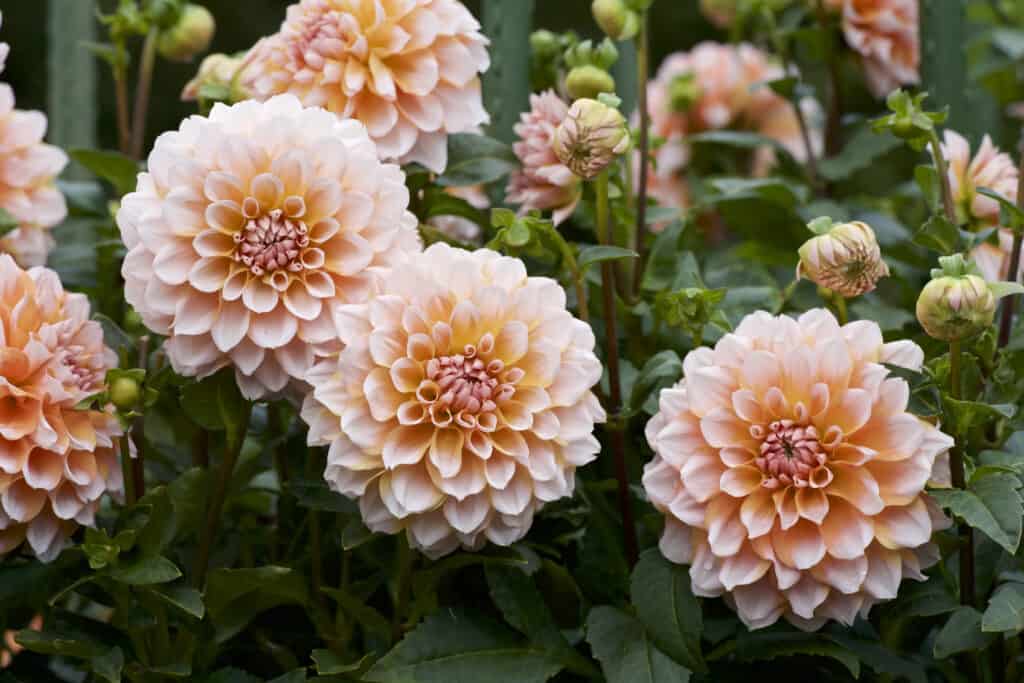
There are many different types of dahlias, including cactus dahlias, ball dahlias, pompon dahlias, and waterlily dahlias.
©iStock.com/Billy_Fam
Gorgeous dahlias are a must-have on our list of best annual flowers for Ohio gardens! And though dahlias grow as perennials in warmer climates, they impress as annuals in this region. Plus, you can store dahlia tubers to overwinter and grow again next year.
There are many different types of dahlias, including cactus dahlias, ball dahlias, pompon dahlias, and waterlily dahlias. In addition, dahlias come in many colors, including white, yellow, pink, red, purple, and orange. The flowers can be single or double blooms and range in size from about 2 inches to 12 inches. Dahlias are a popular choice for cutting gardens as they make beautiful bouquets.
Dahlias are native to Mexico, Central America, and Colombia. They are tuberous plants that grow best in full sun but will tolerate some shade. The dahlia plant prefers well-drained soil. If you use fertilizer, ensure it’s high in potassium and phosphorous, but not nitrogen. If dahlias get too much nitrogen, they won’t produce many blooms.
8. Dianthus

Dianthus barbatus come in many colors, including pink, white, red, and purple, though the most common color is pink.
©iStock.com/Iva Vagnerova
A dianthus plant is a great option if you’re looking for a versatile annual flower to grow in the sun or shade. These garden flowers come in many colors, including pink, white, red, and purple, though the most common color is pink. Dianthus prefers well-drained soil and consistent watering.
You’re probably very familiar with dianthus flowers but might not know it. The carnation (Dianthus caryophyllus) is a type of dianthus flower! So, since the carnation is popular at flower shops, you might already know that dianthus blooms have delicately fringed petals with a sweet fragrance.
Here’s a good reason to plant dianthus in your Ohio garden beds – deer don’t eat them! Plus, they provide lots of nectar for bees and butterflies.
9. Gazania
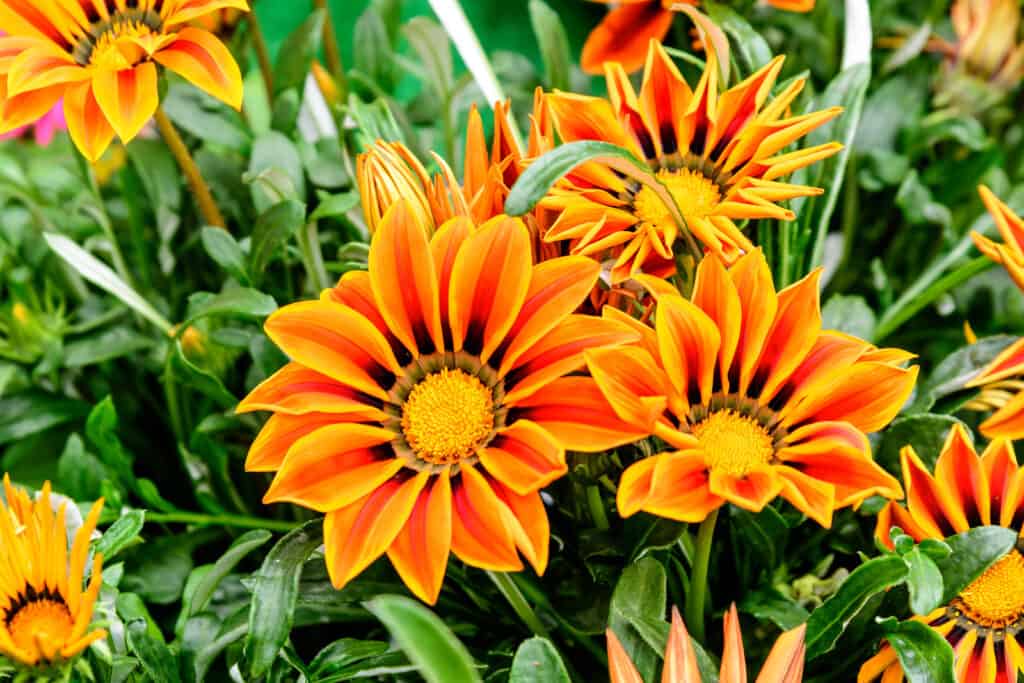
Vivid orange gazania flowers are daisy-like with petals that have dark markings at their centers.
©iStock.com/Cristina Ionescu
The gazania or “treasure flower” is a striking annual that blooms in various colors, including bi-color combinations like cream with pink or gold with orange. The flowers are daisy-like with petals that have dark markings at their centers. Gazanias prefer full sun and well-drained soil.
Gazanias should be at the top of your list if you love showy annuals that are easy to grow and maintain. These heat-loving annuals native to South Africa thrive in hot, dry conditions and most soil types.
Gazanias get high marks as one of the best annual flowers for Ohio for their excellent performance without much gardening work! But deadhead the spent blooms if you want them to flower again before the first frost.
10. Impatiens
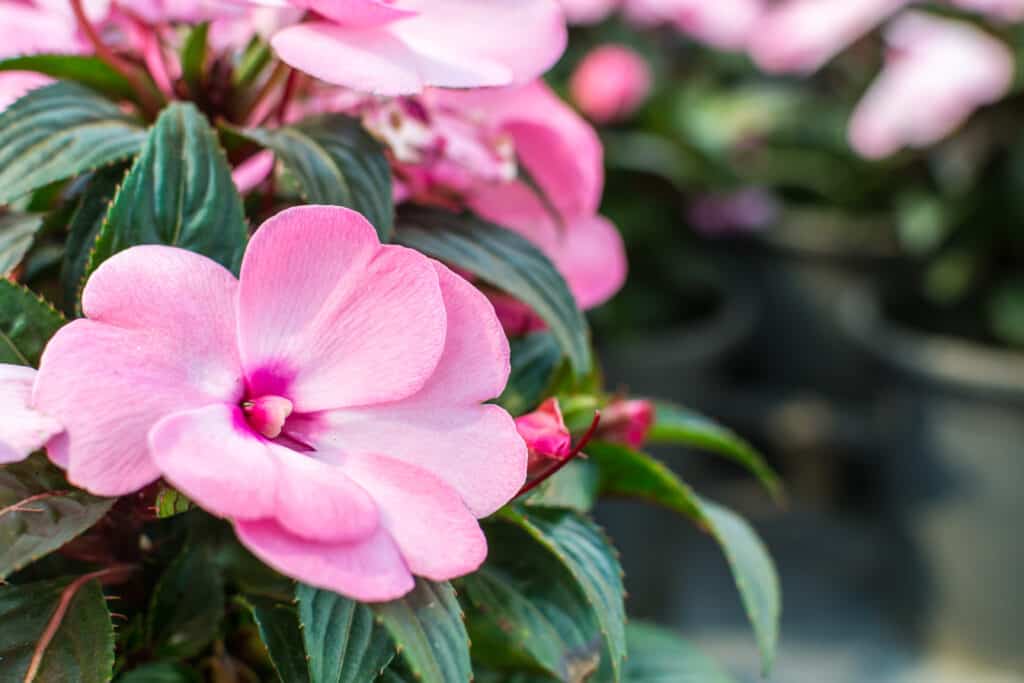
Impatiens blooms come in a wide range of colors, like red, orange, and purple.
©iStock.com/loveischiangrai
Shade-loving impatiens are popular for Ohio gardens and containers because they are also nearly effortless to maintain. In addition, impatiens provide a splash of color in shady areas. Impatiens are also somewhat tolerant of drought and can take some light frost, making them a good choice for late-season plantings.
However, don’t let impatiens stay in the cold for too long, or they will quickly turn mushy. Instead, consider overwintering them in pots indoors to keep them alive all year long.
Impatiens blooms come in a wide range of colors, like red, orange, and purple. The impatiens plant prefers moist soil, but not to the point of soggy. In addition, they don’t need deadheading to produce a near-constant display of elegant blooms.
11. Lobelias

The lobelia flower is a great choice for Ohio gardens as it’s heat tolerant and will produce blooms all summer long.
©iStock.com/Nadya So
Lobelia is a compact annual flower that produces bright and tiny blooms in a beautiful mass. This trailing plant thrives in full sun to partial shade and does best in moist, well-drained soil.
The lobelia flower is a great choice for Ohio gardens as it’s heat tolerant and will produce blooms all summer long. It makes an excellent container plant, too! If you love the look of many tiny blue, pink, or red flowers practically bursting out of window boxes, pots, and hanging baskets, lobelia will not disappoint.
One thing to remember with lobelia is that this plant can spread quickly. Therefore, you may need to deadhead the spent blooms regularly to prevent them from taking over your garden.
12. Marigolds
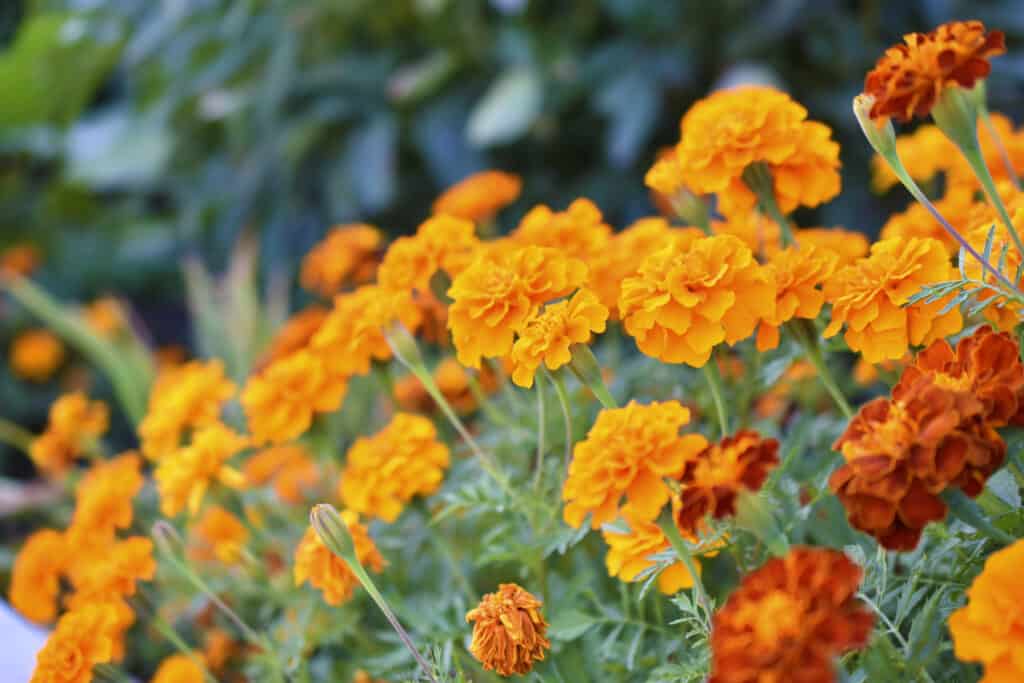
The marigold has ruffled petals, and the center of the flower is typically more compact than the outer petals.
©iStock.com/Valeriy Lushchikov
A bright and cheery option for adding color to your garden, marigolds are perfect for beginning gardeners. Marigolds come in a small range of warm colors, including yellow, orange, and red. They are heat tolerant and thrive in full sun, so plant your marigolds as bedding or container flowers in sunny areas.
The marigold has ruffled petals, and the center of the flower is typically more compact than the outer petals. Marigolds can be found in many different sizes, from small flowers only a few inches wide to large flowers that span several inches. The marigold is a popular choice for gardens and landscaping due to its cheerful color and ability to bloom in various conditions.
Marigolds are a perfect flower to plant in September (late summer) for fall blooming. And sometimes, fall-planted marigolds are even more productive than the ones you planted in the spring!
13. Pansies
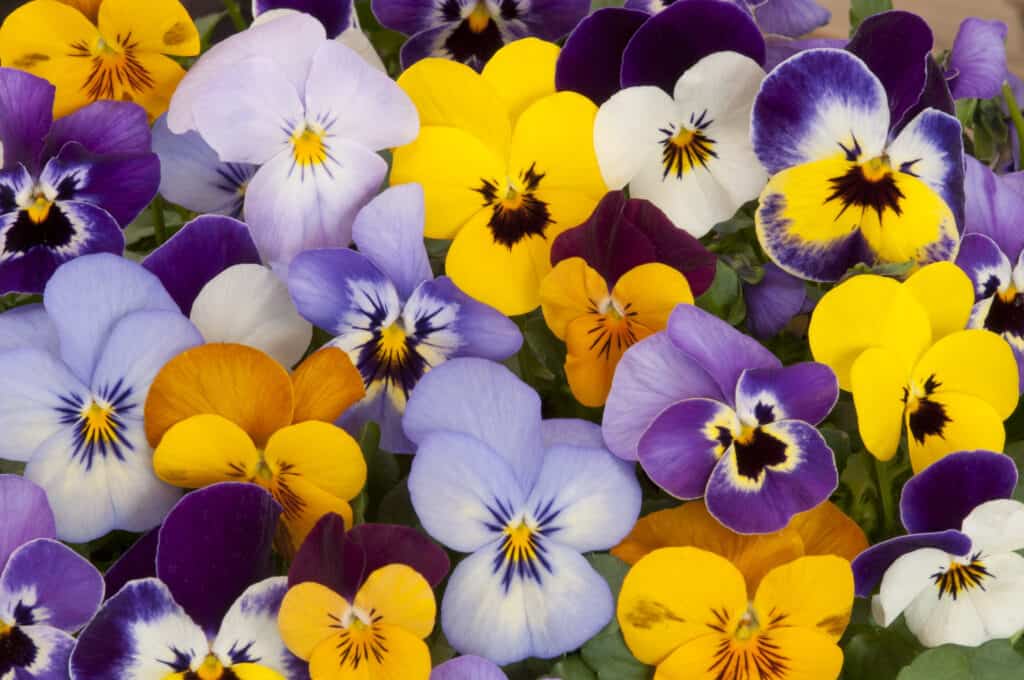
Pansies are versatile and thrive in beds, containers, or as delicate-looking ground cover.
©iStock.com/AnjoKanFotografie
The pansy is one of the first annual flowers to bloom in the spring. This cheerful little flower comes in many colors, including bi-color combinations like yellow and purple or white and blue.
Pansies thrive in full sun but can also tolerate some shade. However, they prefer cool temperatures, so they are a good choice for early spring plantings.
Pansies are one of the best annual flowers for Ohio because they can take some frost and often re-bloom in the fall. Pansies are versatile and thrive in beds, containers, or as delicate-looking ground cover.
Plus, you can pick some pansy blooms and toss them on salads or display them on cakes for a pretty garnish! Yes, pansies are edible flowers that bring a touch of colorful style to many different foods.
14. Petunia
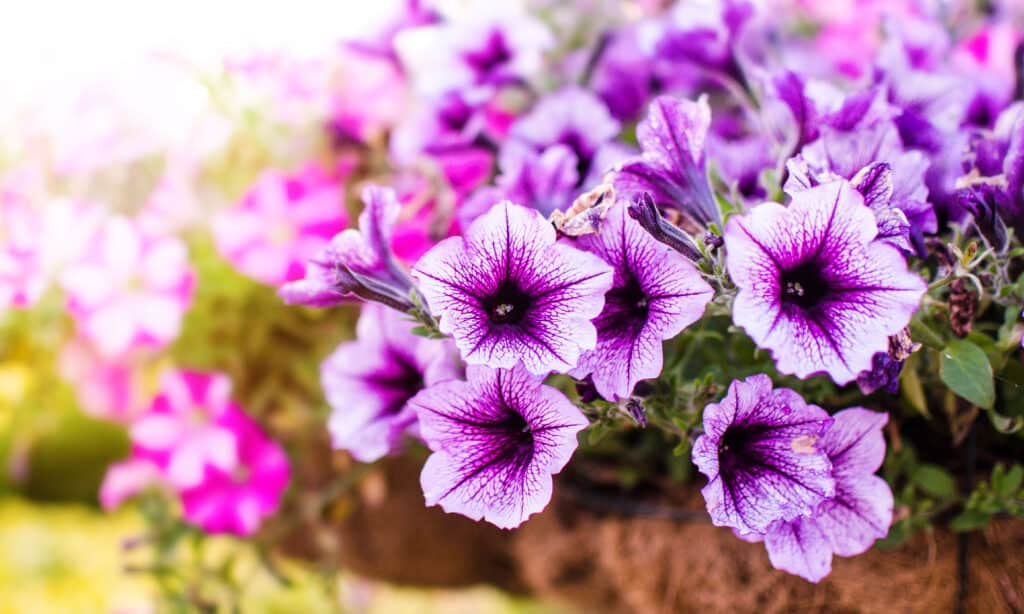
Despite their susceptibility to rotting and mildew, petunias are still popular in gardens due to their vibrant colors and low maintenance.
©Maya Afzaal/Shutterstock.com
Petunias are another classic annual flower perfect for adding color and interest to your garden. They come in various colors and are known for their ease of care. Petunias prefer full sun to partial shade and do best in moist, well-drained soil.
Petunias come in both upright and trailing varieties. The trailing petunias are perfect for hanging baskets and window boxes.
One thing to keep in mind with petunias is that they are susceptible to several diseases, including root rot, powdery mildew, and stem rot. So water petunias at the base of the plant rather than getting the leaves wet. And be sure to remove any diseased leaves or stems promptly to prevent the spread of disease.
Despite their susceptibility to rotting and mildew, petunias are still popular in gardens due to their vibrant colors and low maintenance. Plus, they attract bees, butterflies, and hummingbirds, so they are great for adding some extra wildlife to your home!
15. Torenias
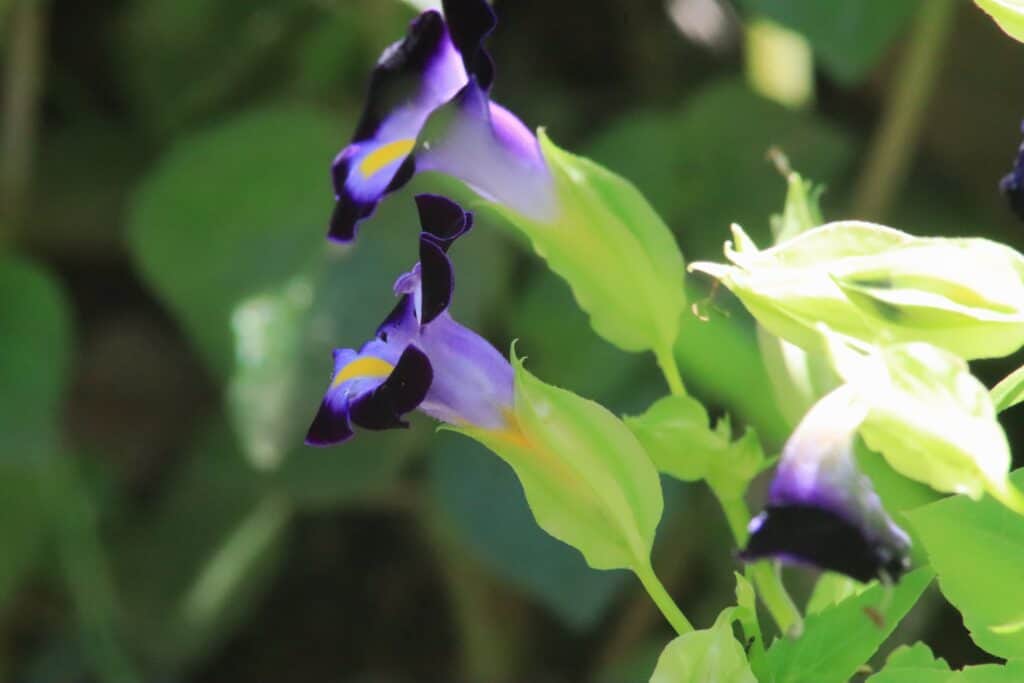
Torenia comes in many colors, including yellow, orange, pink, red, purple, and white.
©iStock.com/Andi Rahim
Torenia might be better known as the “wishbone flower,” and it’s another excellent option for adding color to your Ohio garden. Plus, torenia blooms have stunning, slender trumpet shapes that hummingbirds adore for collecting nectar.
This annual flower comes in many colors, including yellow, orange, pink, red, purple, and white. Torenia is heat tolerant and prefers full sun. However, it can also tolerate some shade.
Torenia is a fairly low-maintenance plant. Therefore, it is not susceptible to many diseases or pests. However, it can be vulnerable to root rot if it is overwatered.
Did you know that torenia’s common name, “wishbone flower,” was named after its wishbone-shaped stamen? It’s true! And, as a fun side note, the wishbone flower has heart-shaped leaves.
16. Vinca
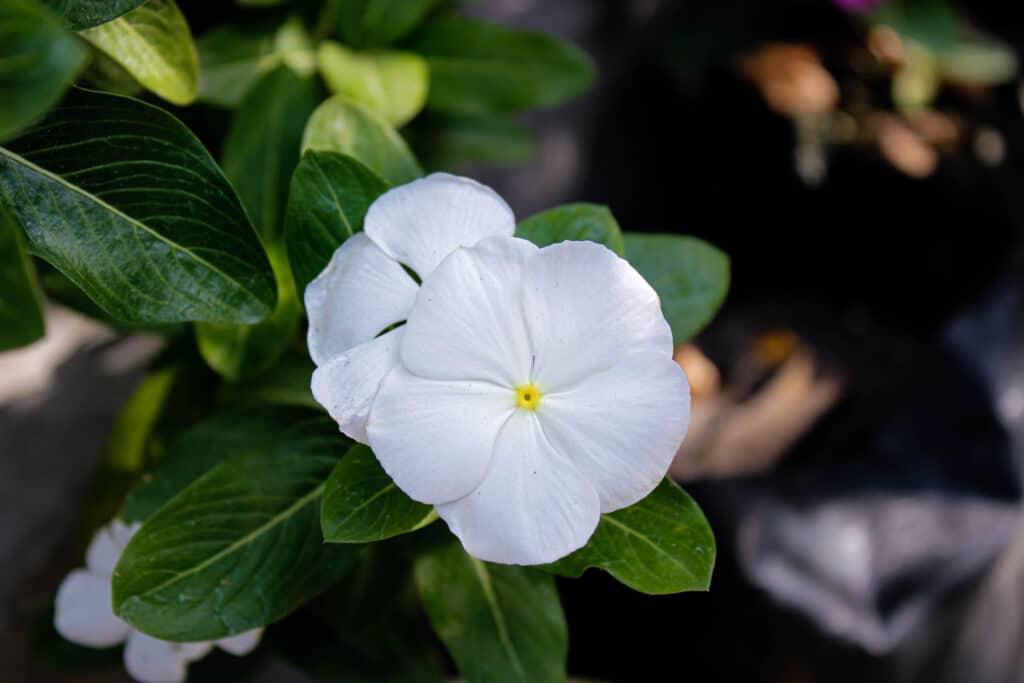
The vinca plant comes in a couple of sizes (big and lesser periwinkle) and a wide range of colors, including white, pink, purple, and blue.
©iStock.com/Prasetyani i
The vinca flower, also known as periwinkle, is a beautiful annual flower that produces delicate, star-shaped flowers. The vinca plant comes in a couple of sizes (big and lesser periwinkle) and a wide range of colors, including white, pink, purple, and blue.
Vinca major varieties (big periwinkle) have blooms about 2-inches in size. Whereas vinca minor varieties (lesser periwinkle) have flowers about 1 inch in size.
This versatile plant can be used as ground cover or in hanging baskets and window boxes. Vinca is heat tolerant and prefers full sun to partial shade.
Vinca is a low-maintenance plant that is not susceptible to many diseases or pests. However, vinca might develop root rot if it is overwatered.
This flower is a great choice for Ohio gardens because it blooms all summer! Plus, the flowers are attractive to bees and butterflies.
17. Zinnia
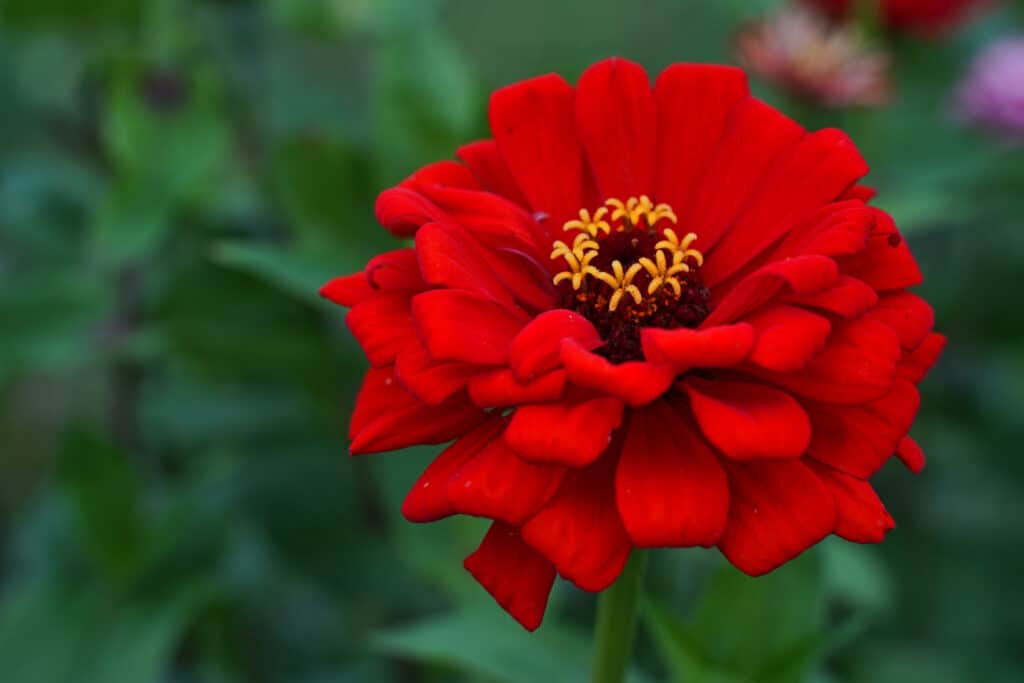
Zinnias come in a variety of colors and petal shapes.
©iStock.com/Kathy Reasor
Zinnias are one of the easiest annual flowers to grow in Ohio gardens and containers. They’re brightly colored and perfect for cut flower beds or pots on a sunny deck. Zinnia plants thrive in full sun and well-drained soil and bloom from mid-summer to fall.
Zinnias are drought tolerant, making them a low-maintenance addition to the garden. With proper care, zinnias will provide colorful blooms all season long.
There are many varieties of zinnias, making it easy to find the perfect one for your garden. Some popular types include Dreamland, California Giants, and “Cut and Come Again.”
When zinnias start to grow from seed, thin the plants to about 12 inches apart. Zinnias need room to grow and spread out.
Though they tend to taste bitter, some people add zinnia petals to salads, decorative ice cubes, and edible decorations for desserts. Though, as with all edible flowers, don’t eat zinnia petals if they’ve been sprayed with garden chemicals.
Planting the best annual flowers for Ohio gardens is easy and satisfying!
Even if you prefer planting perennials in your Ohio pots and beds, annual flowers provide a lot of rewards for gardeners. The annuals we feature here are easy to grow and produce spectacular blooms in the right conditions. So give them a go!
We hope this flower list has helped you narrow your choices for the best annual flowers for your Ohio garden. Happy gardening!
Summary Of The 17 Best Annual Flowers For Ohio Gardens
| # | Flower | Best Area to Plant |
|---|---|---|
| 1 | Astor | full sun to partial shade |
| 2 | Baby’s Breath | full sun to partial shade |
| 3 | Begonias | prefer shady areas |
| 4 | Bidens | full sun |
| 5 | Celosia | full sun |
| 6 | Cosmos | full sun |
| 7 | Dahlias | full sun |
| 8 | Dianthus | full sun |
| 9 | Gazanias | full sun |
| 10 | Impatiens | partial shade |
| 11 | Lobelias | full sun to partial shade |
| 12 | Marigolds | full sun |
| 13 | Pansies | full sun but can tolerate some shade |
| 14 | Petunia | full sun to partial shade |
| 15 | Torenias | full sun |
| 16 | Vinca | full sun to partial shade |
| 17 | Zinnia | full sun |
The photo featured at the top of this post is © iStock.com/Nadya So
Sources
- Ohio State University, Available here: https://guernsey.osu.edu/program-areas/master-gardener-volunteers/news-guernsey-county-master-gardeners/dahlias
- Gardenia, Available here: https://www.gardenia.net/plant/bidens-ferulifolia
- Canton Road Garden Center, Available here: https://www.cantonroadgarden.com/greenhouse/details/annuals/c28/
Thank you for reading! Have some feedback for us? Contact the AZ Animals editorial team.






